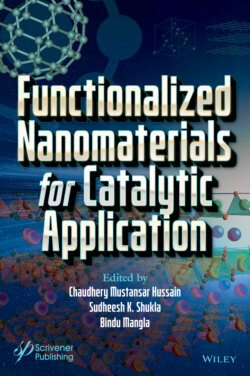Читать книгу Functionalized Nanomaterials for Catalytic Application - Группа авторов - Страница 14
1.2 Electrocatalysts as FNMs
ОглавлениеPresently, the grave situation to be monitored is the impairment by undesirable activities of human race caused to the eco-system [33]. Industrial revolution, production, and utilization are accused for the deliveries of contaminants into the environment. Accumulation of unwanted that alters the food chain is to be checked. Alternatives are worked upon for removing the undesirables in a simple and cost-effective stable way [34]. Poor functioning of ECs at anodic end at low T°C leads to cathodic poisoning to retard the process sometimes [35]. Functionalization of materials can overcome this situation. Surface modification was achieved by using functionalized Pt/C as EC, to give a powerful potential for methanol oxidation [36]. The limitations like high-cost approach, non-availability, and restrictions in poisoning of intermediates [37, 38] while using pure Pt, narrows Pt’s attraction, and utility as EC are now masked by other suitable alternatives [39]. Conductivity of the EC is improved by surface modification, such that cathode attains a high electrocatalytic property. This can be best achieved by functionalization modules of NMs [40]. A schematic depiction of electrocatalytic degradative action in the presence of FNMs that easily removes the contaminants, to protect the water system is shown in Figure 1.2.
An effective catalytic reducing ability was noticed by Qiu, L. et al., while using Au/PPy NTs as EC in gauging fuel cell’s capability for waste effluent water management. 4-NP was the targeted compound in this experiment [41]. FNM nano-TiO2/C membrane, an EC got by sol-gel technique, had an efficient removal of diesel oil (100%) from wastewater. Authors Yang, Y. et al., observed that ECMR was a key enhancer in this situation [42]. The choice of material, a primary factor in wastewater management, was focused in the reports of Bankole, M.Y. et al., where PHB/CNTs and P-CNTs (P-Purified) had a worthy removal of heavy metals like [Fe (15.92% and 15.11%), Cr (98.19% and 99.80%), As (99.95% and 99.99%), Cd (99.34% and 98.68%), Pb (98.85% and 99.44%), Cu (83.08% and 82.91%), Zn (18.34% and 21.80%), and Ni (77.95% and 78.06%)] in redox fashion [43]. Nitrobenzene, a carcinogenic contaminant associated with dyes, pesticides, explosives, and pharmaceuticals, was successfully resolved and degraded to 99.8% in 5 h by FNM TiO2-NTs/SnO2-Sb/PbO2 electrocatalytically with an increased stability at a potential of 2.00 V [44]. In a similar protocol, the working trials were conducted for electrocatalytic action for degrading the organic contaminant benzoic acid. The mesoporous structured material TiO2-NTs/m-SnO2-Sb that was produced by electro-deposition process had a significant removal efficacy [45]. Pd/TiO2 NTs got by electro-chemical deposition method excellently removed 2,4,5-PCB (90%) by electrocatalytic dehydro-halogenation process [46].
Figure 1.2 Electrocatalytic degradative action to protect the water system.
